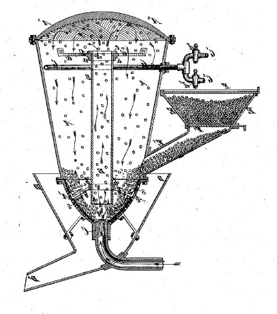 The fluid impact jet mill for micronizing vegetables was first used in 1882 by the American Gustavus O. Goessling. The conical grinding chamber was fed with gas through a single nozzle in the lower part of the grinding chamber, and at the same time the grinding material was fed through a hopper on the side of the grinding chamber in the lower part of the grinding chamber, which was carried by the gas stream to the upper lid of the grinding chamber, against which the grinding material was broken and crushed. Separation and recirculation of the ground material was accomplished by means of a sieve at the bottom of the grinding chamber. This micronization process in this form is no longer used today.
The fluid impact jet mill for micronizing vegetables was first used in 1882 by the American Gustavus O. Goessling. The conical grinding chamber was fed with gas through a single nozzle in the lower part of the grinding chamber, and at the same time the grinding material was fed through a hopper on the side of the grinding chamber in the lower part of the grinding chamber, which was carried by the gas stream to the upper lid of the grinding chamber, against which the grinding material was broken and crushed. Separation and recirculation of the ground material was accomplished by means of a sieve at the bottom of the grinding chamber. This micronization process in this form is no longer used today.
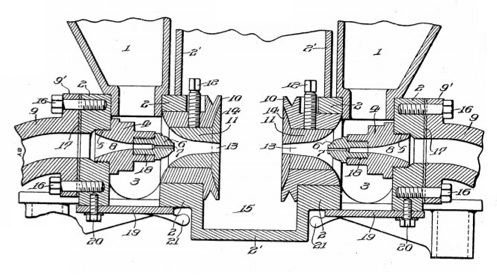 The countercurrent jet mill was introduced by the American Alfred B. Willoughby in 1917. In the cylindrical grinding chamber of the mill, the material to be ground was fed between two horizontally opposed nozzles with compressed air, steam, or other medium. Under these conditions, the particles of the ground material were broken up and crushed by themselves until they were fine enough to be carried by the stream of media to the centrifugal classifier at the top of the grinding chamber. This micronization process in this form is no longer used today.
The countercurrent jet mill was introduced by the American Alfred B. Willoughby in 1917. In the cylindrical grinding chamber of the mill, the material to be ground was fed between two horizontally opposed nozzles with compressed air, steam, or other medium. Under these conditions, the particles of the ground material were broken up and crushed by themselves until they were fine enough to be carried by the stream of media to the centrifugal classifier at the top of the grinding chamber. This micronization process in this form is no longer used today.
The spiral jet mill, also known as a Micronizer, was introduced in 1934 by the American company STURTEVANT. This type of micronizing equipment consists of a flat cylindrical grinding chamber equipped with a circumferential system of 6 to 20 nozzles, all of which are all directed in a single tangential direction at an angle between 30° and 75° inside the grinding chamber. Compressed air or other suitable medium is drawn into the grinding chamber through the nozzles, creating an artificial cyclone of the medium used, rotating in one direction inside the grinding chamber. At the same time, the material 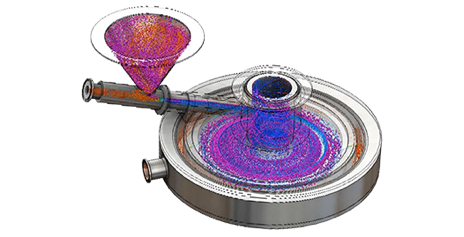 to be ground is introduced into the grinding chamber through a single funnel, which exits into an ejector on the lid of the grinding chamber. Air or another suitable medium is introduced into the ejector, which is accelerated to a very high velocity by passing through an injector built into the ejector, and at this speed the material is injected from the hopper into the interior of the grinding chamber. In the grinding chamber, an artificial cyclone is created with the particles of the ground material at a very high, even supersonic speed, rotating in one direction, where the particles of the material collide with themselves due to the supersonic flow of the medium from the nozzles and the ejector, and are thus micronized. The centrifugal force pushes the largest particles to the periphery of the grinding chamber where they circulate until they are fine enough to pass through the opening in the center of the grinding chamber into the separator for further processing. The mill feed remains in the working chamber for approximately 10 to 20 seconds, while the carrier medium remains in the chamber for a hundredth of that time. The jet spiral mill is typically used for micronizing materials with a hardness of max. 4 on the Mohs scale, but after the application of special abrasion-resistant coatings on the inner surfaces of the grinding chamber, it can also be used for materials with a much higher hardness.
to be ground is introduced into the grinding chamber through a single funnel, which exits into an ejector on the lid of the grinding chamber. Air or another suitable medium is introduced into the ejector, which is accelerated to a very high velocity by passing through an injector built into the ejector, and at this speed the material is injected from the hopper into the interior of the grinding chamber. In the grinding chamber, an artificial cyclone is created with the particles of the ground material at a very high, even supersonic speed, rotating in one direction, where the particles of the material collide with themselves due to the supersonic flow of the medium from the nozzles and the ejector, and are thus micronized. The centrifugal force pushes the largest particles to the periphery of the grinding chamber where they circulate until they are fine enough to pass through the opening in the center of the grinding chamber into the separator for further processing. The mill feed remains in the working chamber for approximately 10 to 20 seconds, while the carrier medium remains in the chamber for a hundredth of that time. The jet spiral mill is typically used for micronizing materials with a hardness of max. 4 on the Mohs scale, but after the application of special abrasion-resistant coatings on the inner surfaces of the grinding chamber, it can also be used for materials with a much higher hardness.
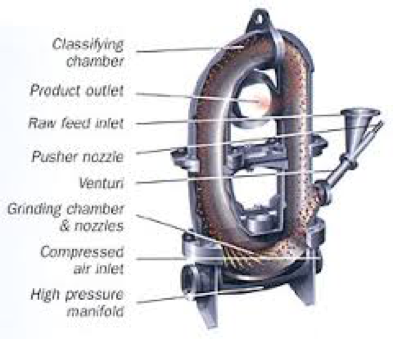 The oval chamber jet mill was developed by the American company FLUID ENERGY in 1941 under the trade name Jet-O-Mizer. It has a vertical grinding chamber made of an oval tube in which air nozzles are located only in the lower part and the air flowing from them is directed in one direction only. The particles of the material to be ground are pulverized by impact, with the fine particles being entrained by the outgoing air in the upper part of the mill, while the large particles are carried back to the grinding zone in the lower part by inertial centrifugal force, where the material to be ground is also fed. The mill is used for the micronization of solid materials, including plastics with a hardness of max. 4 on the Mohs scale.
The oval chamber jet mill was developed by the American company FLUID ENERGY in 1941 under the trade name Jet-O-Mizer. It has a vertical grinding chamber made of an oval tube in which air nozzles are located only in the lower part and the air flowing from them is directed in one direction only. The particles of the material to be ground are pulverized by impact, with the fine particles being entrained by the outgoing air in the upper part of the mill, while the large particles are carried back to the grinding zone in the lower part by inertial centrifugal force, where the material to be ground is also fed. The mill is used for the micronization of solid materials, including plastics with a hardness of max. 4 on the Mohs scale.
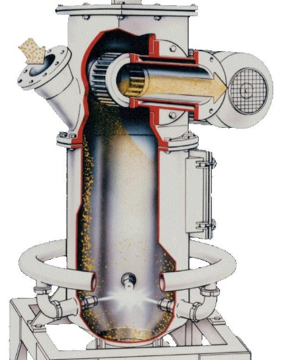 The fluidised bed (opposite) jet mill was introduced in 1981 by the German company ALPINE. It consists of a grinding chamber without moving parts in the form of a closed, elongated cylinder, in the lower part of which 3 to 6 Laval nozzles with supersonic speed of the medium enter in a horizontal plane exactly opposite to each other, bringing the ground material into a fluidized state. The material to be ground is fed into the mill from the upper part of the grinding chamber, from where it passes to the lower part of the grinding chamber, where it is micronized by the flow of the medium passing through the nozzles by mutual impact and friction of the particles, the ground particles being practically not in contact with the nozzles or the walls of the grinding chamber. The micronized particles are returned by the air stream to the upper part of the grinding chamber where an air classifier is located to convey the very finely ground fraction to the separator, while the larger particles are returned to the lower part of the grinding chamber for regrinding. The mill is used for micronizing materials of any hardness.
The fluidised bed (opposite) jet mill was introduced in 1981 by the German company ALPINE. It consists of a grinding chamber without moving parts in the form of a closed, elongated cylinder, in the lower part of which 3 to 6 Laval nozzles with supersonic speed of the medium enter in a horizontal plane exactly opposite to each other, bringing the ground material into a fluidized state. The material to be ground is fed into the mill from the upper part of the grinding chamber, from where it passes to the lower part of the grinding chamber, where it is micronized by the flow of the medium passing through the nozzles by mutual impact and friction of the particles, the ground particles being practically not in contact with the nozzles or the walls of the grinding chamber. The micronized particles are returned by the air stream to the upper part of the grinding chamber where an air classifier is located to convey the very finely ground fraction to the separator, while the larger particles are returned to the lower part of the grinding chamber for regrinding. The mill is used for micronizing materials of any hardness.
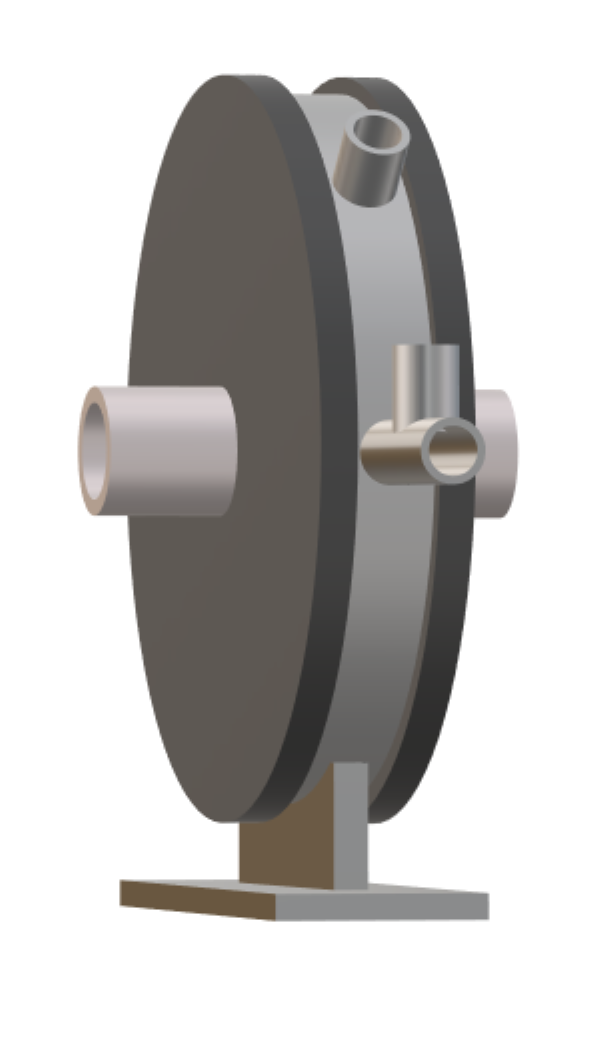 The spiral opposite jet mill was introduced by the Czech company FIMILL in 2019. In the vertical flat cylindrical grinding chamber, the particles of the material to be ground are given very high kinetic energy by a stream of compressed air or other suitable media blown into the grinding chamber at supersonic speed by a system of Laval nozzles. Unlike the spiral jet mill described above, in this mill the nozzles are arranged in adjacent rows around the perimeter of the grinding chamber, with each row of nozzles having a slope opposite to that of the adjacent row. As in a fludised bed (opposite) jet mill, the grinding material is micronized mostly by repeated frontal impacts of the particles against each other. The micronized material is carried out of the grinding chamber by the media flow through two opposing orifices in the center of the grinding chamber, the insufficiently micronized particles are continuously returned to the grinding chamber for regrinding. The mill feeds the ground material into the grinding chamber itself without an ejector. The mill is suitable for micronizing materials of any hardness.
The spiral opposite jet mill was introduced by the Czech company FIMILL in 2019. In the vertical flat cylindrical grinding chamber, the particles of the material to be ground are given very high kinetic energy by a stream of compressed air or other suitable media blown into the grinding chamber at supersonic speed by a system of Laval nozzles. Unlike the spiral jet mill described above, in this mill the nozzles are arranged in adjacent rows around the perimeter of the grinding chamber, with each row of nozzles having a slope opposite to that of the adjacent row. As in a fludised bed (opposite) jet mill, the grinding material is micronized mostly by repeated frontal impacts of the particles against each other. The micronized material is carried out of the grinding chamber by the media flow through two opposing orifices in the center of the grinding chamber, the insufficiently micronized particles are continuously returned to the grinding chamber for regrinding. The mill feeds the ground material into the grinding chamber itself without an ejector. The mill is suitable for micronizing materials of any hardness.